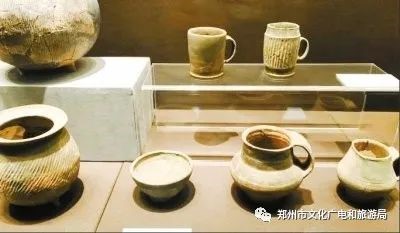A Tour of Zhengzhou to Understand Early China | Eye-catching Cultural Relics in Zhengzhou Museum
Entering a museum is embarking on a journey across time and space. When you wander in the "Time-Opening Capital" exhibition hall in Zhengzhou Museum, you will suddenly encounter some artifacts that seem to have traveled through time and space.

Let's walk into the "Time-Opening Capital" in Zhengzhou Museum and learn about Zhengzhou, the famous historical and cultural city in China.
A "Scooter" in the Museum? A Tool for Husking Grains
From the Paleolithic Age to the Neolithic Age, the agricultural civilization of the Central Plains gradually formed, developed, merged, and then spread in the foothills of Songshan Mountain.
The stone grinding plates and grinding sticks of the Peiligang Culture period displayed in the Zhengzhou Museum are similar to today's scooters. At that time, as agricultural production reached a certain level, people had already raised livestock and developed a relatively advanced technique for producing ground stone tools.
Grinding stones are rough in texture and were used to unshell grains.
Stone shovels for farming, stone sickles for harvesting and the millstone plates and rods for rough processing indicate that there was a complete system for agricultural production and different tools were used throughout the process.
Was There a Connecting Suite in Dahe Village 5,000 Years Ago? The Evidence of Our Ancestors' Improvement of Living Conditions
During the Neolithic Yangshao Culture period, Dahe Village residents adopted the "Wood & Bone" architectural style to build houses. Today, the "first house in the world" is still exhibited in the Dahe Village Ruins Museum, which retains the complete plane layout. The houses are lined up from east to west and are connected by the same wall. Each house has its own door. Hai Weiting said that the complex structure of the connected houses suggested that the houses were owned by families. The houses vary in size, which reflects the hierarchies then.
Is This a Dual-camera Model Machine? It Is Actually a Stone Shovel
Among the cultural relics of the Yangshao Culture period, a cultural relic like a dual-camera model machine made some children wonder why a mobile phone case was put in the showcase.
In fact, its name is double-hole stone shovel. The stone shovel was used for agricultural production, which is common among the cultural relics unearthed from the Yangshao era. However, its color, double holes, and smoothness make people mistake it for a mobile phone case.
Was There a "Mug" 4,000 Years Ago? It Was Unearthed in Xushui Town, Zhengzhou
The two cultural relics of the Longshan period displayed in parallel in Zhengzhou Museum have convinced many people that the staff must have made a mistake and put a mug for drinking water into the showcase.
The gray pottery cup on display is actually a cultural relic of the Longshan Culture period in the Neolithic Age, though similar to today's mugs.
This item was discovered at the Mazhuang site in Zhengzhou. The Mazhuang site can date from the late middle period of the Longshan culture in Henan, where the transmutation process of some major cultural relics features obvious continuity and periodicity.
Is This a Bronze "Small Electric Fan" of the Eastern Zhou Dynasty? It's Part of an Ancient Chariot
A "small electric fan" from the Eastern Zhou Dynasty is displayed in the "Time-Opening Capital" exhibition hall of Zhengzhou Museum. The bell ball has a circular cavity, with a hole in the middle of the front. Eight triangular perforations are radially and equidistantly distributed outward. The whole consists of three parts: the bell ball, the bell neck and the base. The base is narrow at the top and wide at the bottom. The ladder-shaped base is hollow.
This is a hollow bronze bell, which is actually part of an ancient chariot. The bell is placed on the crossbar for producing sound. It is commonly set on the yoke. The bell decorates the chariot, which can make a pleasant sound when the vehicle runs.